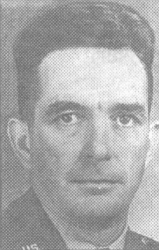
 |
|
|
||
|
Richard Elmer Ellsworth |
||||
|
Graduate, U.S. Military Academy, Class of 1935 Engagements: • World War II (1941 - 1945) |
||||
| Biography: | ||||
|
Richard Elmer Ellsworth Richard Elmer Ellsworth was born in 1911 in Erie, PA. Ellsworth joined the Pennsylvania National Guard in 1929. In 1931 he was accepted into the U.S. Military Academy and, after graduation, studied pilot training at Randolph and Kelly fields in Texas. Ellsworth was assigned to squadron duties in October 1936 at Mitchel Field in New York. The army promoted him to First Lieutenant in June 1938 and transferred him back to Kelly Field and later to Sacramento Air Depot, CA. He spent time studying Meteorology at the California Institute of Technology, graduating with a Master's degree. He received a promotion to Captain in October 1940. By December 1941, Ellsworth was a Major and by February 1942, a Lieutenant Colonel. World War II In the spring of 1942, Ellsworth was assigned to transport pilot duty in Alaska. Later that year, he was sent to study weather-related phenomena in the South Pacific, where he was promoted to Colonel in December. Beginning in July 1943, as Commander of the Tenth Weather Region, he flew more than 400 combat missions in the China-Burma-India Theater, logging a total of 780 hours for the 10th and 14th Air Forces. For his heroics, he received battle stars for eight different campaigns. Cold War After the war, Ellsworth returned to the U.S. for reassignment as Chief of Operations and Training for the Air Weather Service in Washington. He later commanded the 308th Reconnaissance Group at Morrison Field, FL, as well as Fairfield-Suisun AFB, CA. In July 1950, Ellsworth graduated from the Air War College at Maxwell AFB, AL, and was assigned as Chief of Plans for the 2nd Air Force at Barksdale AFB, LA. Colonel Ellsworth was assigned as the Wing Commander, 28th Strategic Reconnaissance Wing at Rapid City AFB, SD, in 1950. In September 1952, he was promoted to Brigadier General. Retired squadron maintenance officers at the Base remember Ellsworth as an unusual, hands-on commander, who would sometimes assist mechanics working late into the night in efforts to ready aircraft. In the early 1950s, Ellsworth befriended Hollywood producer Herman Cohen during the filming of Battles of Chief Pontiac. The picture was shot on-location in western South Dakota, using Lakota Indians from a nearby reservation to portray the Native Americans. General Ellsworth allowed personnel from the base to act as extras in the film, portraying British and Hessian troops. Ellsworth sent out Air Force water trucks to assist the production crew. Ellsworth's three sons were allowed to visit the set and meet the actors. Airplane Crash On 18 March 1953, Ellsworth was co-piloting a Convair RB-36H Peacemaker bomber on a 25-hour journey as part of a simulated combat mission flying from Lajes, Azores, back to the Rapid City base. As part of their exercise, the bomber was observing radio silence and had switched off their radar guidance, flying via celestial navigation. They had planned to fly low over the ocean, steadily increasing to higher altitudes before reaching the mountainous countryside of Newfoundland. Late into the night, the aircraft struck bad weather and went off course, reaching Newfoundland 90 minutes earlier than planned. At 4:10 AM at a hill near Burgoyne's Cove, inland from Nut Cove, Trinity Bay, Newfoundland, with sleet, fog, freezing drizzle, and visibility estimated at less than one-eighth of a mile, the plane struck an 896-foot hill at 800 feet with a ground speed of 202 knots. The aircraft's propellers severed the tops of pine trees while the plane's left wing hit the ground, tore off, and spilled fuel. The rest of the plane impacted some thousand feet further. The impact and subsequent fire from the plane's fuel tanks scorched an 8-foot-deep trench in the countryside. Loggers on a nearby hill spotted the fireball and alerted rescuers, but all 23 on board were killed on impact. That same night, a Boeing SB-29 Superfortress search and rescue plane was sent out to assist in search efforts. It disappeared and was presumed crashed as well. In the aftermath of the crash, an accident investigation board recommended new procedures to scan more frequently for approaching high terrain and to climb to safer altitudes before approaching within 200 miles of a water-land boundary. Crash Site The remote crash site is one of only two B-36 crash sites still remaining (the other is in Alaska). Wreckage is strewn across 3⁄4-mile of terrain, and remains today where it landed. The site is located about a 40-minute hike away from the nearest parking area. A nearby memorial features a propeller from the bomber, and a bronze plaque listing the names of the deceased crewmembers. Medals and Awards Legion of Merit Badges and Insignia Command Pilot Badge Honors President Dwight Eisenhower personally went to the Rapid City base and re-named it Ellsworth Air Force Base, to honor Brigadier General Ellsworth. Death and Burial Brigadier General Richard Elmer Ellsworth died on 18 March 1953 in Newfoundland, Canada. He is buried at Black Hills National Cemetery in Sturgis, SD. |
||||
| Honoree ID: 2466 | Created by: MHOH | |||
Ribbons
Medals
Badges
Honoree Photos
 |  |  |
 |  |
 |


